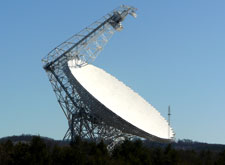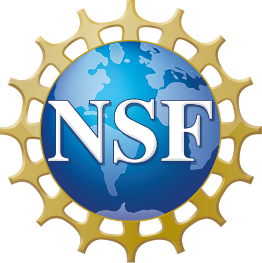GBT Azimuth Track Replacement Project
Status Reports from Todd Hunter
Monday, October 1, 2007
The PTCS team has developed and implemented a new pointing model for the GBT. This model incorporates the new azimuth track inclinometer data in a geometrically accurate manner via lookup tables with 0.1 degree resolution. Repeated measurements of the new track over the timescale of a week have shown it to be stable, but it will be monitored occasionally during the coming year. The large amount of pointing data acquired during the past few weeks has resulted in some improvement in other terms of the pointing model as well. Based on 200 measurements scattered about the sky (from elevations of 10 to 83 degrees), the nighttime (10pm-8am) blind pointing performance of the new model shows a standard deviation of 3.4 arcsec in cross-elevation and 3.8 arcsec in elevation. For daytime performance, these values rise to 4.3 arcsec and 6.5 arcsec, respectively. The offset pointing performance will be analyzed next.
Monday, September 10, 2007
Upon completion of the azimuth track refurbishment, we immediately began to characterize the new track. We spent the first night performing slow azimuth scans (360 degrees over 2.5 hours) while recording the inclinometer data streams. Similar scans had been performed in April on the old track. The new track shows a marked improvement in performance. Both the large scale and small scale structure in the local tilt as a function of azimuth has been greatly reduced. As an example, the figure below compares the local tilt in a 20 degree segment of the old track versus the new track.
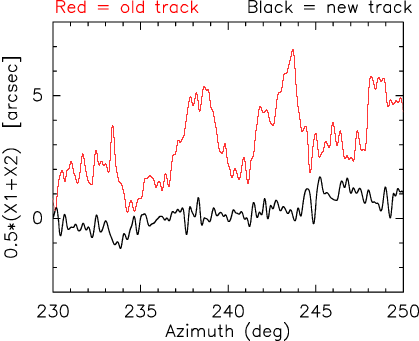
Following the track scans, we obtained 60 hours of all-sky X-band pointing, equally distributed between day and night. These data will be used along with the inclinometer data to fit a new pointing model that includes the traditional gravitational and thermal terms, as well as lookup tables that account for the remaining track features. The task for the next few weeks is to incorporate the new model in the system and to verify its performance.
GBT Azimuth Track Replacement Project
GBT Back in Full Operation
Monday, September 3, 2007
At 8:00 this morning we had the privilege of walking around the GBT track, in step with the antenna, as it did its first complete 360 degree rotation since completion of the azimuth track replacement work last Saturday (and after curing of the last section of grout). The rotation of the telescope was as smooth as silk.
The first new pointing observations were made by Green Bank staff astronomers at 10:00 this morning. These were performed with our old pointing model, but with all of the track corrections set to zero. The image below shows the very first pointing observation. With absolutely no corrections other than the basic model, the measured offsets were 3" in azimuth and 1.5" in elevation!
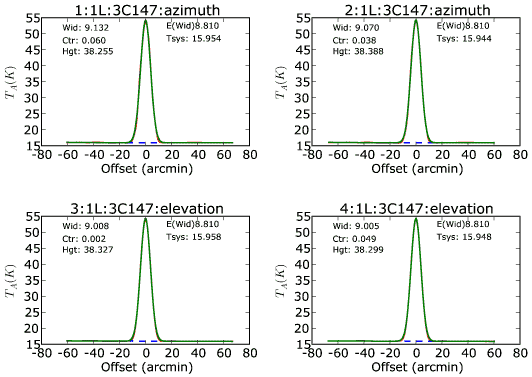
Subsequent pointing observations have gone smoothly throughout the day and into the night. The initial results from inclinometry data are also looking extremely promising. We plan to spend the next two weeks completely characterizing the performance of the antenna, to derive the full pointing model. However, these initial results are very encouraging.
We would like to thank everyone who has been involved in this project - their commitment and dedication in getting the job done has been outstanding.
GBT Azimuth Track Replacement Project
Status Reports from Bob Anderson
Wednesday, September 5, 2007
Following the release of the telescope for pointing tests on September 3, (see above) the contractors are putting the finishing touches on the track and foundation. They are dressing the grout surfaces, applying sealers and caulking to screw holes, and filling any remaining construction joints and surface cracks. The field contractor, General Dynamics, is cleaning up the site, returning rented equipment to the suppliers, and preparing to ship their tool trailers out this week or early next. The last day they expect to be on site is Friday, September 7.
NRAO employees are also at work, preparing to waterproof the foundation to ground level and coat the epoxy grout with a sealer and ultraviolet light inhibitor, and put a coating on the exposed steel surfaces. Their work should finish next week, weather permitting.
On behalf of the Project Team, I would like to thank everyone who contributed to this effort. Even though a lot of thought and planning was done in advance, NRAO employees and the contractors' employees applied their skills and experience many times to address unexpected tasks. As soon as a task was performed, the people involved thought ahead to develop ways to make the work go faster or easier. Everyone was dedicated to the quality of the end product, and not in cutting corners. And, it was done safely, with the handful of injuries being a sprain, stiff muscles, or a scratch or two.
We hope that this project enables astronomers many years of exciting new discoveries, particularly in the higher radio frequency range of the spectrum.
And, if you wear this track out, we'll build you another one!
Monday, August 27, 2007
Machining on three of the four final tie-in welds has now been completed, and machining of the final weld should be finished early this week. The work remaining after that consists of the final leveling and grouting of these areas. Barring equipment failure or weather delays, the field work will be completed by Saturday 1st September.
Monday, August 20, 2007
Work continues on machining the distorted weld sections. We are making good progress, but have been interrupted on two nights because of thunderstorms. We expect to finish up around the middle of next week, barring further interruptions.
Tuesday, August 14, 2007
The track completion date unfortunately has slipped by about 10 days with a new estimate for completion not before August 26 or 27.
The final four tie-in welds were finished and inspected early last week. These welds caused the adjacent areas to bow upward by 0.050 inch. In addition, the surface very close to the weld drew down by about 0.010 inch. The distortion problems are being corrected by building up the low areas with weld and by machining down the high areas. Weld build-up of the low areas is nearing completion. A crew is setting up to machine flat the high areas. This work must be done at night when the sun's warmth doesn't distort the track or affect the measurement process. This effort should finish next week.
Over the weekend the final measurement of the plate heights for the unaffected sections was completed satisfactorily. We are in the process of finishing by mid week the grouting under the splice plates and base plates.
The recent abnormally high temperatures in Green Bank are also affecting work. Plates are storing heat, which affects the alignment effort at night. And, the grout moves very slowly and cures faster at warmer ambient temperatures.
As per our original plans, during the four weeks after the track is completed we will schedule low frequency observations as we parameterize the pointing with the new track.
Friday, August 3, 2007
Work is being completed at a fast pace this week. By this morning only two base plate welds remain to be made. The welds will be inspected on Monday, and final alignment and machining of the weld tops will occur next week. Workers are also building the forms for the installation of the remaining grout. We still expect the track to be complete enough so that pointing runs can begin by mid-August.
Monday, July 30, 2007
The GBT will be moved to approximately Azimuth 184.45 degrees tomorrow morning around 0800 hours.
This move is expected to be the last before completion of the project. As of this morning, we have six welds remaining, and about 20 sections of grout to install. Our efforts over the past few days have focused on the painstaking work of fitting in place the last sections of base plates. General Dynamics employees, some Continental employees, and some of us (NRAO employees) have worked portions of, or all of, these last sections every day since July 9.
Several people have inquired about the lights on the telescope at night. The lights are on because we have night crews working, in addition to the day crews, performing alignment and welding tasks. At present, we expect to complete the track replacement and release it for pointing tasks sometime between August 15 and August 19. Clean-up and surface finishing of the grout and steel sections will continue for about a week after that.
Go for the moon. If you don't get it, you'll still be heading for a star. - Willis Reed
Friday, July 20, 2007
Phase 2 work continues at a steady pace. As of today, we have completed 8 of the 16 remaining welds. Next week, we begin final height checks of some sections, then we will grout them in, and move the telescope one last time to allow the final base plate to be installed on or before July 30. We've had good weather with only a few interruptions by thunderstorms.
Friday, July 13, 2007
The last of the structural concrete was poured this morning. In one location we found an area of concrete that had to be removed, and this has been replaced with a higher strength, quick setting product.
This morning Continental Field Systems arrived to start the first of the Phase 2 welds. Tomorrow a second alignment instrument and operator arrive to help with the alignment of the plates. From now on the track work returns to a 24 hour 7 day week schedule, continuing this way until nearly the end of the project.
Friday, July 6, 2007
Phase 2 is progressing to plan, and we anticipate completion of the work by mid-August, followed by about one month of recommissioning the pointing model of the telescope.
Friday, June 29, 2007
The GBT rolled onto the new track sections this morning to permit installation of the remaining plates. The design team and installers watched closely as the telescope moved onto first the transition sections between the old and new track, and then onto the new plates. All went well.
While much remains to be done, today's move is a significant milestone event. The team of contractors and NRAO staff has overcome many hurdles in phase 1, and we've got some ideas on how to make the remaining work go easier and faster.
Friday, June 22, 2007
We are now getting close to completion of the Phase 1 work. All four sections of new track are in place, aligned with each other and leveled. We are now in the process of placing the grout to tie the steel to the concrete foundation. This work should finish early next week, and after allowing for curing, we'll move the telescope to the first position for Phase 2 work. By next Friday, we'll begin demolition of the remaining old track sections.
Saturday, June 16, 2007
All Phase 1 base plate and wear plates are in place, and have been welded and machined. The sections are being aligned and leveled. The first section has completed this process, and the level looks very good.
We have experienced a lot of delay this week due to rain and fog, which can affect welding and hamper the laser alignment equipment. We are a little over two weeks behind schedule, but are looking for opportunities to make up the time. Our current projected completion date is August 15.
Why is the GBT azimuth track being replaced?
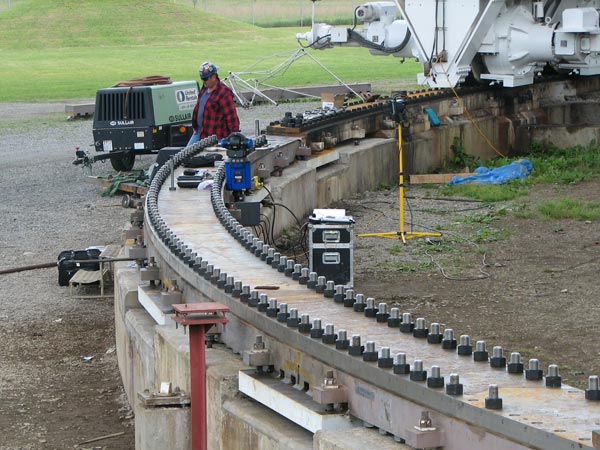
First Section Ready for Service
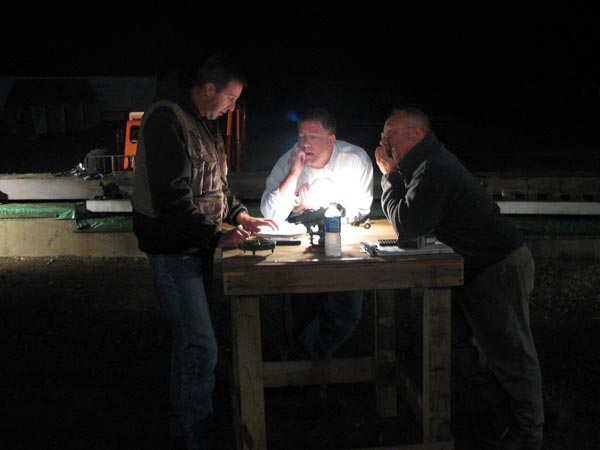
Night Time Surveying
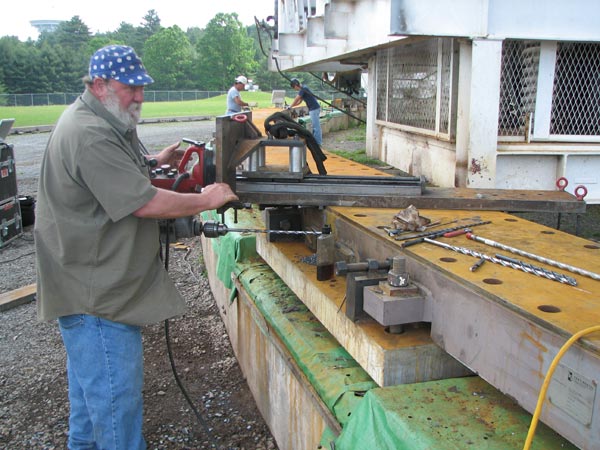
Drilling Out Weld Root
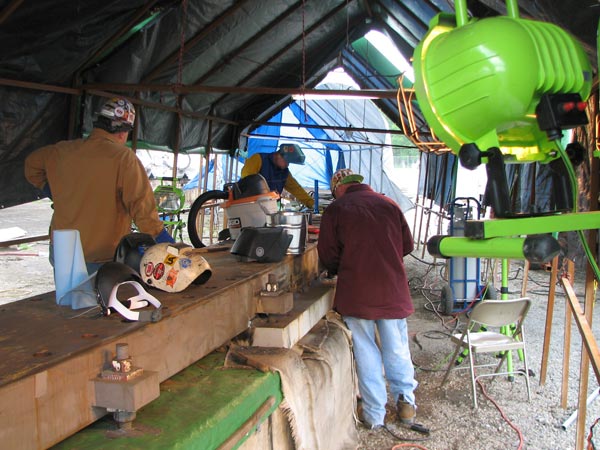
Welding Splice Plates
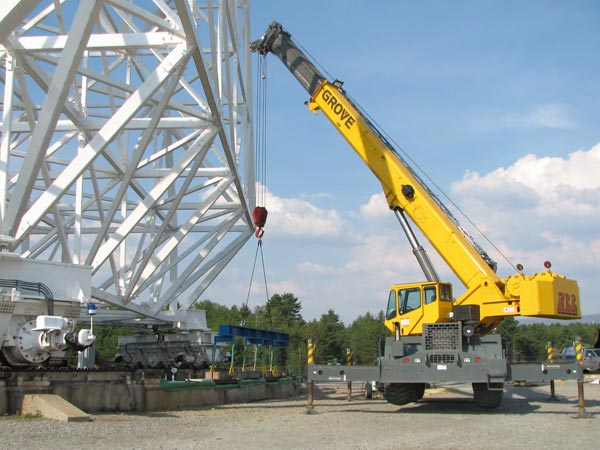
Setting of First Base Plate
Why is the GBT azimuth track being replaced?
The GBT azimuth track is being replaced because deterioration of track components was found during the early commissioning phase of the telescope. The basic cause of the deterioration is the high wheel load - over one million pounds per wheel of dead load, which is the highest loading of any wheel on rail application known. The goal of the replacement is to restore the 20 year service life of the components.
The replacement involves every component of the track between the top of the concrete foundation and the bottom of the wheels:
- New, higher strength base plates, made from bridge steel. Each base plate will be welded to the next, and also to the splice plates below each joint.
- New, tougher wear plates. These plates will have higher impact and fatigue strengths, and be over 50% thicker than the existing plates. The wear plates will overlap the joints of the base plates below them. The wear plates will also be as wide as the base plates beneath them, and have a v-shaped joint instead of the 45 degree mitred joint used previously.
- A layer of bronze/teflon/molybdenum will be sandwiched between the wear plates and the base plates to reduce the chance of fretting wear.
- The plates will be held together by bolts that go all the way through both the wear plates and base plates. These will replace the screws that go only a short distance into the base plates. The bolts will be located further away from the wheel path to reduce fatigue stresses on them.
- The cement grout that fills the void between the base plates and the top of the concrete will be replaced by a high strength, two part epoxy grout. The old grout was packed into the void by hand, whereas the new grout will be poured in and allowed to completely fill the void.
This work started on April 30, and should finish during August. The telescope will remain on the track during this time, and the four 1/8th arc segments between the wheels will be replaced. The telescope will then be driven onto the new sections, and the remaining 1/8th arc sections will be replaced. Following final engineering checkout, the telescope will enter a one month phase of recharacterization and shared risk observing.
GBT Track Upgrade Podcast
Green Bank's Mike Holstine describes the project to replace the GBT track this summer. Originally recorded for the monthly radio show Mountain Radio Astronomy on March 24, 2007.

